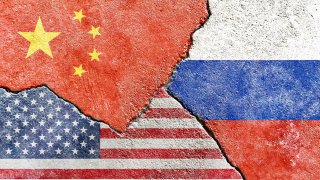Washington Should Divide, Not Unite, Russia and China
There are still opportunities to drive a wedge between Russia and China, just as when Richard Nixon exploited the Sino-Soviet split.
Russia and China recently wrapped up a series of joint air and naval exercises dubbed “Northern/Interaction-2023.” Chinese state media hailed the exercises as a “substantive manifestation of the China-Russia strategic partnership.” The drills took place off the coast of Japan, spooking one of America’s most crucial allies in Asia.
Then, in what one analyst called a “highly provocative” move and a “historical first,” a joint Russian and Chinese naval flotilla approached the coast of Alaska. Biden administration officials downplayed the news, emphasizing that the patrol took place in international waters. But a Republican senator from Alaska cited the naval patrol as evidence of “a new era of authoritarian aggression.”
Some fear these developments signal an emerging power bloc in Asia bent on contesting American influence. Yet leading officials and commentators often fail to understand how the United States itself helped create the conditions for increasing Russo-Chinese alignment. Military cooperation between Moscow and Beijing is not simply an inevitable convergence of like-minded authoritarian states, as the popular narrative suggests. It is also a direct response to American muscle-flexing in the region.
In the past year, the United States has needled China in several ways. Washington sent a nuclear-armed submarine to South Korea in a show of force, bolstered its partnership with India, and deepened strategic coordination with other Quadrilateral Security Dialogue (“Quad”) members. Washington also held landmark military exercises with Japan and cut a deal to station more troops in the Philippines.
Undoubtedly, U.S. policymakers view these moves simply as proportionate responses to China’s escalating territorial claims and hostile rhetoric against Taiwan. But one side’s deterrence is another side’s provocation. When Washington rallies its partners for displays of military force and integrates Pacific states further into its network of military alliances, Beijing is apt to perceive threats to its regional interests. International relations theory predicts that states often choose to bandwagon with others when they feel the need to balance against the hostile intentions of rival powers. For better or for worse, when the United States bolsters its defense posture in Asia, China will naturally see a balancing coalition partner in Russia.
Since the end of the Cold War, the China-Russia relationship has ranged from bitter competition to cautious collaboration. But in recent years, Washington’s assertive posture in Asia has driven Beijing to pursue increased military cooperation with Moscow. A similar trend is apparent in the Arctic. Russia traditionally views China’s strategic Arctic aspirations with suspicion, but a U.S.-led boycott of the Arctic Council has spurred Russia to increase cooperation with China in the region. The two countries used America’s absence at the Arctic Council meeting to further cement security ties.
To be sure, the relationship between Russia and China remains hugely unequal. Despite touting a “no-limits partnership” between the nations, Beijing has in fact made the limits of its cooperation quite clear. Its state oil firm Sinopec has abandoned talks on investment in Russian oil projects. Apart from purchasing Russian commodities at discounted prices, China has largely adhered to international sanctions on Russia in the wake of its invasion of Ukraine. Beijing continues to preach neutrality in the Ukraine war rather than explicitly supporting Russia’s position and has spurned Russian requests for weapons, instead proposing a peace plan containing provisions that would be hard for Moscow to swallow.
China’s approach to the war in Ukraine is indicative of its rationale for strengthening defense ties with Russia. Vladimir Putin has framed the invasion as an existential battle against NATO and the entire U.S.-led security architecture. China’s reluctance to fully throw its global weight behind Moscow in the conflict—in arms, finance, and diplomatic support—is telling.
Rather than joining a wide-ranging authoritarian crusade against the liberal international order, China’s partnership with Moscow is narrowly focused on regions where it perceives critical security interests. For all the hype around the purported emergence of a new axis of authoritarian powers bound together by ideology, the deepening Russia-China relationship smacks of standard realpolitik. As the United States flexes its muscles across Asia to protect its economic, security, and global governance interests, China will inevitably do the same. Shunned by the West, Moscow is a logical partner in augmenting Beijing’s military might.
There are still opportunities to drive a wedge between Russia and China, just as when Richard Nixon exploited the Sino-Soviet split to establish relations with Mao during the Cold War. China must carefully weigh the military advantages of Russian partnership against its still-important economic ties to the United States. After Secretary of State Antony Blinken visited Beijing in June, the Bank of China announced limits on Russian clients’ transactions involving banks in several Western countries, in what could be interpreted as a conciliatory gesture towards Washington.
The United States has been quick to use its military prowess and diplomatic clout to expand its power in China’s backyard. It has hesitated, however, to creatively exploit the long-fraught relationship between Moscow and Beijing. If Washington elects to mount a myopic contest for influence in Asia but forgoes creative diplomatic engagement with China, it won’t just miss an opportunity to split China from Russia once again. It will instead create incentives for these two great powers to join forces, fueling the outcome it fears most.
Mark Hannah is a senior fellow at the Eurasia Group Foundation and host of its None Of The Above podcast.
Image: Shutterstock.

